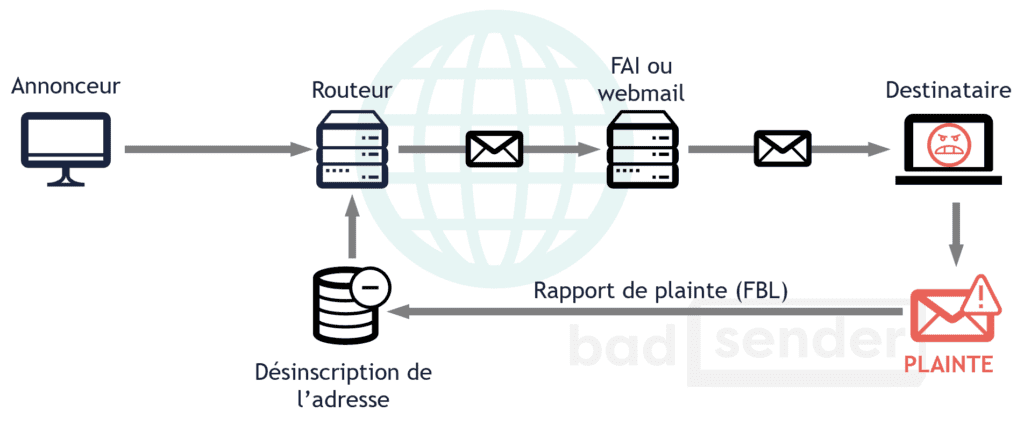A spam complaint feedback loop (FBL) is a technical process that allows an email sender to be informed when a recipient triggers a spam complaint. Generally, access to the Feedback Loop of an ISP or webmail is conditional on the approval of a charter.

Let's take the ACME company newsletter as an example. This company uses the routing tool of EmailRoutingCorp. On Monday, ACME sends out its newsletter for the week. Roger, who is a Hotmail user, receives it and thinks, "damn, I can't find the unsubscribe link". And bam, he classifies the message as spam. EmailRoutingCorp, which sets up Hotmail's feedback loop for all of its customers, receives a message from Hotmail telling it that Roger has made a complaint. The router can now automatically unsubscribe Roger from the ACME list so that he is never contacted again. If ACME generates too many spam complaints, EmailRoutingCorp will also have the opportunity to hold ACME accountable to protect its reputation.
The benefits of feedback loops
- For the recipients The main advantage for the consumer is to have a way to unsubscribe even when the advertiser does not respect its obligations in this matter.
- For advertisers Spam complaints are an important indicator of the recipient's perception of the messages sent to them. Feedback loops are the only way to track this indicator. Moreover, having the opportunity to unsubscribe recipients based on a feedback loop also reduces the number of complaints in the long term (which will inevitably have a positive impact on deliverability).
- For the routing platform For the router, monitoring the complaint rate is a good way to detect good and bad senders. In certain circumstances, in order not to affect their reputation, sending platforms can suspend or even exclude accounts generating too many complaints. In the same way, by automatically blocking all addresses of recipients who have made a complaint for a particular advertiser, routers protect themselves against potential deliverability incidents.
- For ISPs For the ISP, the advantage is obvious, to reduce the number of illegitimate messages and thus satisfy its users. But also participate with the router to fight effectively against spam.
Which webmails/FAIs offer a feedback loop?
Note: This section was updated on November 3, 2016 to reflect the latest changes on the topic
We will limit ourselves to the French market so as not to end up with too long a list. It should be noted that some players have been offering a feedback loop for several years. Concerning French ISPs, the movement is more recent but things have largely evolved since the end of 2013 with the implementation by Orange of the feedback loop developed by Signal Spam :
- Hotmail/Outlook.com : Has been offering a feedback loop for several years via its JMRPP program (it helps identify complainants)
- AOL : The American company has a feedback loop, to register, it's on its Postmaster site (it allows to identify the complainants)
- Yahoo! : The site offers a feedback loop powered by Return Path,
to register it is here(it allows to identify the complainants) - Gmail Offers a feedback loop that does not precisely identify complainants, but through which it is possible to detect the campaigns and email flows that generate the highest volumes of complaints. More info here.
- Orange Since 2013, Orange has offered an aggregated feedback loop (only volume indications, no individual level identification) via the association Signal Spam.
- SFR Like Orange, SFR integrates the Signal Spam feedback loop.
- Laposte.net : Like SFR and Orange, Laposte.net integrates the Signal Spam feedback loop and since the last quarter of 2016 an FBL (via Return Path) to identify complainants.
- Free : Still no feedback loop at Free.fr.
The role of Return Path in different feedback loops
Need help?
Reading content isn't everything. The best way is to talk to us.

Return Path is a well-known company in the world of email and especially deliverability. Among other things, the company offers services to ISPs to facilitate the creation of feedback loops. For example, many American ISPs use Return Path's services (Comcast, Cox, Rackspace, USA.net ...) but this is also the case for Yahoo! or Terra in Brazil. Since late 2016, Laposte.net also uses Return Path's services for its identified FBL.
Return Path therefore drives a large part of the feedback loops in the world.
In France, SignalSpam at the center of the game

On the French market, we have the chance to find an association centralizing the fight against spam. Indeed, with Orange, Laposte.net and SFR, but also many routers, Signal Spam is in a prime position to structure the management of spam complaints and redistribute the results to the various members of the association.
And technically?
In practice, unless you route your emails internally, you should not need to configure the different feedback loops yourself. However, don't hesitate to ask your router which feedback loops it supports.
Leave a Reply